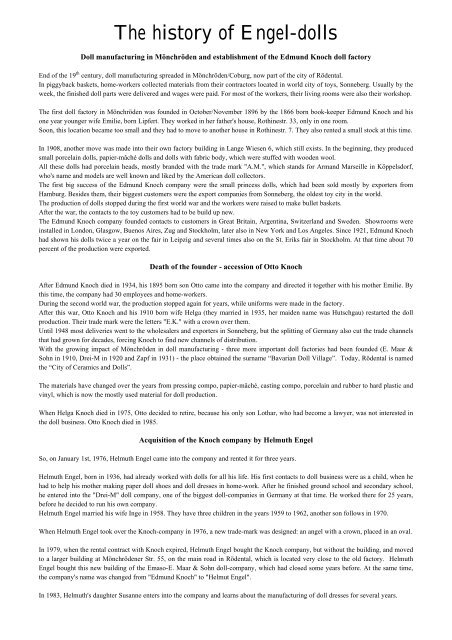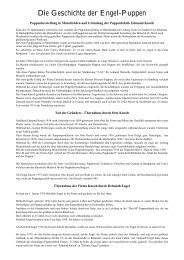The history of Engel-dolls - Engel-Puppen / Engel Dolls
The history of Engel-dolls - Engel-Puppen / Engel Dolls
The history of Engel-dolls - Engel-Puppen / Engel Dolls
- TAGS
- history
- engel
- dolls
- engeldolls.info
Create successful ePaper yourself
Turn your PDF publications into a flip-book with our unique Google optimized e-Paper software.
<strong>The</strong> <strong>history</strong> <strong>of</strong> <strong>Engel</strong>-<strong>dolls</strong><br />
Doll manufacturing in Mönchröden and establishment <strong>of</strong> the Edmund Knoch doll factory<br />
End <strong>of</strong> the 19 th century, doll manufacturing spreaded in Mönchröden/Coburg, now part <strong>of</strong> the city <strong>of</strong> Rödental.<br />
In piggyback baskets, home-workers collected materials from their contractors located in world city <strong>of</strong> toys, Sonneberg. Usually by the<br />
week, the finished doll parts were delivered and wages were paid. For most <strong>of</strong> the workers, their living rooms were also their workshop.<br />
<strong>The</strong> first doll factory in Mönchröden was founded in October/November 1896 by the 1866 born book-keeper Edmund Knoch and his<br />
one year younger wife Emilie, born Lipfert. <strong>The</strong>y worked in her father's house, Rothinestr. 33, only in one room.<br />
Soon, this location became too small and they had to move to another house in Rothinestr. 7. <strong>The</strong>y also rented a small stock at this time.<br />
In 1908, another move was made into their own factory building in Lange Wiesen 6, which still exists. In the beginning, they produced<br />
small porcelain <strong>dolls</strong>, papier-mâché <strong>dolls</strong> and <strong>dolls</strong> with fabric body, which were stuffed with wooden wool.<br />
All these <strong>dolls</strong> had porcelain heads, mostly branded with the trade mark "A.M.", which stands for Armand Marseille in Köppelsdorf,<br />
who's name and models are well known and liked by the American doll collectors.<br />
<strong>The</strong> first big success <strong>of</strong> the Edmund Knoch company were the small princess <strong>dolls</strong>, which had been sold mostly by exporters from<br />
Hamburg. Besides them, their biggest customers were the export companies from Sonneberg, the oldest toy city in the world.<br />
<strong>The</strong> production <strong>of</strong> <strong>dolls</strong> stopped during the first world war and the workers were raised to make bullet baskets.<br />
After the war, the contacts to the toy customers had to be build up new.<br />
<strong>The</strong> Edmund Knoch company founded contacts to customers in Great Britain, Argentina, Switzerland and Sweden. Showrooms were<br />
installed in London, Glasgow, Buenos Aires, Zug and Stockholm, later also in New York and Los Angeles. Since 1921, Edmund Knoch<br />
had shown his <strong>dolls</strong> twice a year on the fair in Leipzig and several times also on the St. Eriks fair in Stockholm. At that time about 70<br />
percent <strong>of</strong> the production were exported.<br />
Death <strong>of</strong> the founder - accession <strong>of</strong> Otto Knoch<br />
After Edmund Knoch died in 1934, his 1895 born son Otto came into the company and directed it together with his mother Emilie. By<br />
this time, the company had 30 employees and home-workers.<br />
During the second world war, the production stopped again for years, while uniforms were made in the factory.<br />
After this war, Otto Knoch and his 1910 born wife Helga (they married in 1935, her maiden name was Hutschgau) restarted the doll<br />
production. <strong>The</strong>ir trade mark were the letters "E.K." with a crown over them.<br />
Until 1948 most deliveries went to the wholesalers and exporters in Sonneberg, but the splitting <strong>of</strong> Germany also cut the trade channels<br />
that had grown for decades, forcing Knoch to find new channels <strong>of</strong> distribution.<br />
With the growing impact <strong>of</strong> Mönchröden in doll manufacturing - three more important doll factories had been founded (E. Maar &<br />
Sohn in 1910, Drei-M in 1920 and Zapf in 1931) - the place obtained the surname “Bavarian Doll Village”. Today, Rödental is named<br />
the “City <strong>of</strong> Ceramics and <strong>Dolls</strong>”.<br />
<strong>The</strong> materials have changed over the years from pressing compo, papier-mâché, casting compo, porcelain and rubber to hard plastic and<br />
vinyl, which is now the mostly used material for doll production.<br />
When Helga Knoch died in 1975, Otto decided to retire, because his only son Lothar, who had become a lawyer, was not interested in<br />
the doll business. Otto Knoch died in 1985.<br />
Acquisition <strong>of</strong> the Knoch company by Helmuth <strong>Engel</strong><br />
So, on January 1st, 1976, Helmuth <strong>Engel</strong> came into the company and rented it for three years.<br />
Helmuth <strong>Engel</strong>, born in 1936, had already worked with <strong>dolls</strong> for all his life. His first contacts to doll business were as a child, when he<br />
had to help his mother making paper doll shoes and doll dresses in home-work. After he finished ground school and secondary school,<br />
he entered into the "Drei-M" doll company, one <strong>of</strong> the biggest doll-companies in Germany at that time. He worked there for 25 years,<br />
before he decided to run his own company.<br />
Helmuth <strong>Engel</strong> married his wife Inge in 1958. <strong>The</strong>y have three children in the years 1959 to 1962, another son follows in 1970.<br />
When Helmuth <strong>Engel</strong> took over the Knoch-company in 1976, a new trade-mark was designed: an angel with a crown, placed in an oval.<br />
In 1979, when the rental contract with Knoch expired, Helmuth <strong>Engel</strong> bought the Knoch company, but without the building, and moved<br />
to a larger building at Mönchrödener Str. 55, on the main road in Rödental, which is located very close to the old factory. Helmuth<br />
<strong>Engel</strong> bought this new building <strong>of</strong> the Emaso-E. Maar & Sohn doll-company, which had closed some years before. At the same time,<br />
the company's name was changed from "Edmund Knoch" to "Helmut <strong>Engel</strong>".<br />
In 1983, Helmuth's daughter Susanne enters into the company and learns about the manufacturing <strong>of</strong> doll dresses for several years.
Since about 1988, she supports Mrs. Gerda Völk, the dress designer, who had followed Helmuth <strong>Engel</strong> from the "Drei-M"-company to<br />
the Knoch company, and later to his own company. By 1992, Susanne <strong>Engel</strong> already created a part <strong>of</strong> the <strong>Engel</strong> collection on her own.<br />
Markus <strong>Engel</strong> enters the company’s succession<br />
When Markus <strong>Engel</strong>, the youngest child <strong>of</strong> Helmuth and Inge <strong>Engel</strong> and designated successor <strong>of</strong> Helmuth <strong>Engel</strong>, entered into the<br />
factory in 1989, the company was changed into a corporation with name "<strong>Engel</strong>-<strong>Puppen</strong> GmbH".<br />
Since several years <strong>Engel</strong> had negotiated with W. Goebel Porzellanfabrik, the manufacturer <strong>of</strong> the world-famous Hummel®-figurines,<br />
about the manufacturing and distribution <strong>of</strong> the M.I. Hummel®-vinyl <strong>dolls</strong>, which succeeded in 1995 and lasted until 2005. At the same<br />
time, Goebel gave <strong>Engel</strong> the license for the models <strong>of</strong> the famous American doll artist Charlot Byi®, which <strong>Engel</strong> manufactured until<br />
2002. Both lines brought new groups <strong>of</strong> customers to <strong>Engel</strong>-<strong>Puppen</strong>, which influenced the business results considerable.<br />
In the celebration year 1996, there were four anniversaries at <strong>Engel</strong>-<strong>Puppen</strong>. Besides the centennial <strong>of</strong> the company and the takeover <strong>of</strong><br />
the company by Helmuth <strong>Engel</strong> 20 years before, the 60 th birthday <strong>of</strong> president Helmuth <strong>Engel</strong> and the 65 th birthday <strong>of</strong> senior-designer<br />
Gerda Völk were celebrated.<br />
<strong>The</strong> very good export business in this year reached about 70 percent <strong>of</strong> the turnover, same as about 75 years before.<br />
In the beginning <strong>of</strong> 1997, Helmuth <strong>Engel</strong> decided to transfer the majority <strong>of</strong> the company to his son. Markus <strong>Engel</strong> at the same time was<br />
appointed to a manager <strong>of</strong> <strong>Engel</strong>-<strong>Puppen</strong> GmbH.<br />
Since November 1999, Markus <strong>Engel</strong> leads the business as the sole manager.<br />
Acquisition <strong>of</strong> the costume doll line from H.u.E. Wilhelm<br />
At the beginning 1950s, Heinrich Wilhelm and his wife Emilie, born Clarner, began to make Black Forest <strong>dolls</strong> in a former carpenter’s<br />
workshop. Later their line was extended with original costumes from all over Germany and the surrounding countries.<br />
Daughter Sonja entered the management <strong>of</strong> the company in 1967, and after Heinrich Wilhelm died in 1972, leaded it together with her<br />
husband Hans Völker.<br />
In October 2001, Sonja and Hans Völker, both now aged over 70, decided to retire.<br />
<strong>Engel</strong>-<strong>Puppen</strong> took over the models <strong>of</strong> the neighborhood company in their own assortment and continues to manufacture the original<br />
costume <strong>dolls</strong> in traditional German handicraft.<br />
Acquisition <strong>of</strong> the Hans Völk <strong>dolls</strong><br />
Hans Völk, born 1893, bought the building <strong>of</strong> the old terracotta factory in Mönchröden. <strong>The</strong>re, on December 8 th , 1922, he founded a<br />
company specialized in punching and stamping paperboard together with his four years younger wife Martha, born Wendler.<br />
From beginning they manufactured <strong>dolls</strong> from paperboard and papier-mâché.<br />
Daughter Lotte, born Aug. 6 th , 1923, and her husband Otto Buchner, born Nov. 6 th , 1923, continued the company in next generation.<br />
Under Lotte Buchner’s artistical influence, additional beautiful doll models were created.<br />
End <strong>of</strong> the 1950s the manufacturing was changed to plastics. Selected <strong>dolls</strong> from the earlier papier-mâché collection were now<br />
manufactured from hard plastic in the blow-moulding process. Together with the rotational moulding technique, which came up in the<br />
late 1950s and was also installed in the factory, the Hans Völk company developed to a modern company in polymer processing.<br />
After Hans Völk died in 1961, Lotte Buchner owned the company together with her mother and after Martha Völk died in 1969, she<br />
became the sole owner. Otto Buchner leaded the company together with her and was mainly involved in technical issues in the<br />
production.<br />
When Lotte Buchner died on Aug. 5 th , 1989, the ownership <strong>of</strong> the company went to Otto Buchner and his daughter Barbara. After Otto<br />
Buchner died on June 29 th , 1995, Barbara Buchner continued the company on her own.<br />
<strong>The</strong> own polymer processing department <strong>of</strong> the Völk company was given up in 1997 and Barbara concentrated the business on the<br />
manufacturing <strong>of</strong> nostalgic collector <strong>dolls</strong> and delivery <strong>of</strong> <strong>dolls</strong> and doll parts to other doll manufacturers.<br />
Wilhelm, the custom doll maker whom <strong>Engel</strong>-<strong>Puppen</strong> had acquired in 2001 was also among Völk’s customers. <strong>The</strong>y had purchased<br />
undressed <strong>dolls</strong> and sold them after dressing them in original regional costumes.<br />
In May 2002 Barbara Buchner decided to give up the doll department, and after short negotiations, the Hans Völk doll models were<br />
taken over by <strong>Engel</strong>-<strong>Puppen</strong>.<br />
Also in 2002, on June 11 th , the fifth family generation in the company’s <strong>history</strong> was founded with the birth <strong>of</strong> Victoria Sundari <strong>Engel</strong>,<br />
daughter <strong>of</strong> Claudia and Markus <strong>Engel</strong>, who had married in 2001.<br />
In 2003, <strong>Engel</strong>-<strong>Puppen</strong> introduced the nostalgic <strong>dolls</strong> <strong>of</strong> the Hans Völk trade-mark, which are still made in the original procedures <strong>of</strong><br />
the 1950s, to their customers.<br />
Together with the Wilhelm original costumes collection and the Hans Völk nostalgic <strong>dolls</strong>, the <strong>Engel</strong>-<strong>Puppen</strong> assortment grew to about<br />
600 different doll styles since 2003, which are still manufactured in Germany by the <strong>Engel</strong>-<strong>Puppen</strong> staff.



